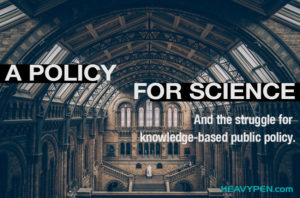
A Policy for Science
Our technological advancements are evidence of a vibrant culture of science and research. Yet science is largely left out of the public policy-making process.
Science is brimming with new and noteworthy discoveries. It’s a marathon to reach a greater understanding of worlds outside our own, and the worlds within. With all of the technological developments that science has helped us achieve, shouldn’t we demand knowledge-based public policy? Even as our libraries swell with volumes of new information and scientific insight, is it a bit off that science usually doesn’t have a seat at the table?
And yet, how difficult it is for science to find political allies in government – let alone be allowed at the table of decision-making. How voters reward special interest with the power to control and pay little regard to science and research. Where’s the incentive for politicians to heed research when voters don’t even understand the data?
Take, for example, the unseasonably hot December days of 1996. It was one of those warm winters that the rest of the world took as normal for California. It was also a season when the rhetoric grew unusually heated. Politicians, pundits, and supporters lined up rank and file to implement a new policy to cut off funding for prenatal care services to undocumented immigrant mothers.
The new policy hailed as one giant leap for responsible fiscal management was, in fact, an edict for 70 thousand undocumented pregnant women, among the poorest segment in California. Touted as a $69 million savings plan for taxpayers, sponsors of the initiative quickly drew on strong support from a groundswell of public opinion that immigrants came to suckle on California’s bounty of social services.
Policy-makers respond to their constituents’ interests, which may not be based on current academic research findings. Thus, public policy may reflect public attitudes more than research findings. — Leo Chavez, Anthropologist
Not so, said University of California anthropologist Leo Chavez. His work found that four out of five illegal immigrant Latinas in Southern California see themselves as part of their community, and nearly two-thirds hope to remain in the United States as productive taxpayers.
The study, derived from hundreds of exhaustive telephone interviews, went further to stipulate that this same group of immigrants does not consider tax-subsidized social services a lure to stay. Despite their low incomes and the presence of children, the use of public assistance and preventive healthcare services was low – in some cases, almost nil when compared to the mainstream population.
Chavez tried to defend his work in a story published by the LA Times in 1996.
“The political rhetoric focused on the negative. They claimed that undocumented immigrants have come to abuse our system and if we stop them from using social services they’ll go back. We’re saying those assumptions are off. These are people who are basically working class and don’t seem to be using exorbitant levels of health care. And they embrace life here, they feel comfortable here. They have an investment here in terms of their jobs and kids.”
Nevertheless, the pundits continued their postulations and pontifications. Without the benefit of any scientific data whatsoever they attacked Chavez and his colleagues branding their hard work as “a complete whitewash of illegal immigration.” It’s the type of scenario that makes scientists cry into their spreadsheets.
Two years later, and with the passage of the anti-immigrant Proposition 187, Chavez is circumspect that science will ever have a role in policy-making.
“Academic research has provided important insights into issues that are of public concern, and which often contradict taken-for-granted assumptions about immigrant intentions and behavior. Sometimes this wealth of data influences public policy. Unfortunately, it is also true that policy-makers respond to their constituents’ interests, which may not be based on current academic research findings. Thus, public policy may reflect public attitudes more than research findings.”
While immigration is a highly emotional topic, Chavez notes a major problem in the creation of fair public policy that is compounded by simple human behavior.
“People often hold beliefs that they know are true because they’ve experienced them, or someone they know has had the experience.”
He adds that this is particularly the case for immigration issues, but can be applied to nearly every aspect of society.
“Even one experience is often enough to make generalizations,” he adds. “Academic research is sometimes undermined, or less accepted, by people who already know the ‘truth’ based upon their taken-for-granted assumptions.”
What is truth, anyhow?
Once my research is known, if it is relevant to a particular legal case, attorneys will find me and cite my work. Attorneys are terrific about soliciting the advice of academic researchers. — Cornelia Pechmann
For the tobacco-marketer, the “truth” was a useful tool in the Golden Age of free marketing. Bracketed by WWI and Vietnam, it was an era where industrialists and merchandisers had free reign on how and where their products were sold. The great marketing sages of the time concocted behavior-modifying promotions to generate brand-name loyalty and lifetime customers. Incredibly – when it was still legal to do so – there were such innocent novelties as candy cigars and bubble gum cigarettes packaged to look just like mommy’s and daddy’s smokes. You could even get the things from the same machines where you could buy real cigarettes.
Marketing researcher Cornelia Pechmann embarked on her first quest for truth in 1991, studying why kids smoke and what impact marketing has on their decision to start. An associate professor at the UCI Graduate School of Management, she sought to learn what children do when exposed to ads that were for or against cigarettes, and how they responded to non-marketing elements such as peer pressure.
Although not quite as politically incendiary as immigration, smoking by children is a timely topic and controversial because of what cigarette marketers have apparently done to promote the use of their products. While lawyers and politicians leaf through the reams of reports for a smoking gun on the industry’s marketing methodologies, Pechmann’s work may bear a better chance to make fundamental changes for the entire tobacco industry.
Her work and the work of other researchers may influence federal, state or local legislation on tobacco marketing restrictions and on tactics such as counter-advertising. Pechmann’s early findings have been cited in the FDA’s ruling to support proposed restrictions on tobacco marketing. She has also met with officials from the Campaign for Tobacco-Free Kids, which is one of the main public health groups gearing up support for the federal tobacco settlement.
Foremost, Pechmann’s efforts may influence the outcomes of several pending legal cases that charges the tobacco industry liable for, among other things, Medi-Cal costs, false claims, and unfair competition.
“It is easier for me to have this type of impact,” says Pechmann. “I simply need to do my job well, publish relevant research in reputable journals, and present my research at conferences and universities. Once my research is known, if it is pertinent to a particular legal case, attorneys will find me and cite my work. Attorneys are terrific about soliciting the advice of academic researchers. They tend not to be intimidated or frustrated by the technical jargon in academic research papers. In my experience, they manage to muddle through the most complex articles to identify the relevant findings for their case.”
Well, that’s one way to set public policy. But to be a fly on the wall of the RJ Reynolds’s board room in those days.
But this cozy relationship between scientist, policy maker, and the public is far from typical. Given that our system of government allows only three ways for public policy to come into being (by legislative order, judicial decision, and executive decree), the scientist is often up against some pretty stiff competition to get people to use their hard-earned data.
You’ve got to shut that guy up. — Dr. F. Sherwood Rowland
In 1974, Dr. F. Sherwood Rowland, Bren Professor of Chemistry at UCI, discovered how serious this competition can be when he announced the discovery that chlorofluorocarbons, common aerosol propellants, and coolants, were eating away the earth’s ozone layer. In 1985, his data and predictions were confirmed which led to the 1987 enactment of the Montreal Protocol of the United Nations Environment Program. Then in 1995, Rowland received the Nobel Prize in chemistry, a timely reward for work that was initially vilified.
When Rowland made his initial discoveries, the nabobs of negativism emerged all at once. The aerosol industry, chemical companies that produced CFCs and the scientists who worked for them, even the Reagan-era EPA, joined to declare that Rowland’s discovery was nothing more than an environmental scare tactic. At one point, representatives of the aerosol industry even tried to get him fired. “They wrote to then-Chancellor Dan Aldrich basically saying, ‘You’ve got to shut that guy up,'” Rowland recalls.
Of course, Rowland and his work prevailed, but he denies that winning the Nobel Prize was a vindication. For that, he observes the measurable results his work has brought. The bulk of the scientific community had always supported his findings, but it was the public who ultimately voted with their dollars. Sales of CFC-based aerosol products gradually evaporated as legislative bodies around the world instituted bans on the chemical. And while the long lifetime of CFCs ensures that much of what is already in the atmosphere will remain for decades, new emissions have been rapidly curtailed.
“Collectively, we’ve found that it’s possible to get international cooperation on a global scientific problem on the basis of scientific observation and consensus,” Rowland comments. “Perhaps this global agreement can be a harbinger of the future; science and technology must play major roles in solving the problems we see all around us, and we all must continue to tell this not just to our colleagues, but to our representatives and to the general public, and we must be prepared to do it over and over again because the understanding is necessary.”
Priorities for public policy management are sometimes dictated by perceptions of the policy makers or the public about risk for which they may have relatively little evidence based on scientific research. — Dr. Dean Baker
Dr. Dean Baker, who heads the Occupational and Environmental Medicine Division at UCI’s Department of Medicine, feels that the current regulatory process defers too much of the decision-making power to the financial interests of the parties involved.
“These financial considerations lead policy makers to ignore or minimize documentation that scientific research has generated about harm,” he says. “Priorities for public policy management are sometimes dictated by perceptions of the policy makers or the public about risk for which they may have relatively little evidence based on scientific research.”
Much of his research involves epidemiological studies of large populations and their exposure to toxic agents. Among Dr. Baker’s collaborators are the National Institute for Allergy and Infectious Diseases (NIAID), the Agency for Toxic Substances and Disease Registry (ATSDR), and the Environmental Protection Agency (EPA). His recent body of work includes studies on inner-city minority children with asthma, a first-of-its-kind study of residents in two communities near Superfund-designated hazardous waste sites, and a project that will measure environmental exposures to lead in Tijuana, Baja California, and Mexico.
Dr. Baker points out that there is “a degree of disconnect” between what is documented and scientific hypothesis. He gives as an example the way in which Congress requests national science organizations like the National Institutes for Health or the National Academy of Science to evaluate specific issues. Rarely, he says, do the organizations use formal mechanisms that involve congressional representatives and bring them to participate from start to finish.
“I think the balance could be improved by encouraging a broader dialogue between the scientific community and public,” he comments. “The opinion that the discussions are ‘too scientific’ for laypersons is the type of opinion that continues to disconnect science from [the policy makers].”
Jonathon Ericson, a UCI professor teaching environmental analysis and design, also expresses his overall dissatisfaction with the role scientific research plays in public policy management. He wishes that policy-makers made greater use of scientist’s work, but he acknowledges that scientific data is often overridden by politicians or public opinion or both – which, he asserts, “is not always warranted or healthful.”
Collaborating with Dr. Baker on the survey of lead poisoning in Mexico, Ericson adds that the public is often the one that is lost in the squeeze between political agendas and economic protection. “The scientist is providing primary information about a particular problem. The politician, if equitable, may be considering the domain and context of the entire problem. In some cases, there is a perfect solution with nearly unanimous consensus on all sides. A good example is the atmospheric test ban treaty [of nuclear weapons] and the scientific data collected to support it. In others there is conflict and the public is placed in the middle.”
Presidents and legislators are not making it any easier to pay the bill for ongoing policy research either. Until last year, federal funding for non-industrial, non-defense research was third in a declining list of funding items in the national budget. According to the Government Accounting Office (GAO), the federal government will spend about $70 billion in 1998 for all scientific research. About 80 percent of this budget is allocated to research and development of various technologies for defense, space, and developing industries.
That means more than 3,400 colleges and universities and thousands of other organizations and private citizens are vying for a slice of a $14 billion pie. If you want to save yourself from doing the math, that’s about $4 million for each college and university, and not counting all the other competing institutions and organizations.
Loren Renz is the vice president of The Foundation Center, a leading non-profit organization that tracks private funding sources. Noting that private funding is up to $13 billion, she also points out that most of the increases are designated for heath policy research while funding for categories for research overall has remained flat.
“Many private funding sources are focused on conservative policy issues along with other like-minded organizations.” According to Renz, such budgets saw sharp increases since the Reagan administration.
Most researchers indicate that while they are happy to get what they can, the demand for general research has fallen sharply. In many cases, particularly the controversial cases like immigration and certain environmental and social studies, funding is entirely non-existent. So, one wonders, how can the policy makers be assured that they aren’t making matters worse with their decisions?
“I personally believe that immigration is going to continue as a major area of significance for the United States,” comments Chavez. “We need more funding to understand how best to develop policies that lead to positive integration of immigrants into society. The more we know now, the better we can plan for the future.”
Back in Nevada, for some folks it seems, even the issue of CFCs is still up for debate. Last year, the Nevada state Assembly considered a bill that would have allowed sale and use of CFCs in that state. The bill was voted down but had it passed it would have been overturned by the national ban.
“They did that to satisfy the hurt feelings of some people,” says Rowland. “But that kind of thinking is indicative of the need for more science education generally.”
Rowland observes that the making of public policy on scientific matters requires detailed scientific knowledge that is not represented in most political bodies. “The legislatures do a reasonable job of representing society in terms of their ignorance of science. The attitude of most legislators is that you can always buy a scientist to erect an opposing side. The news media tends to do this too. Even if 99 percent of scientists are in one camp, they will find one who disagrees because it makes a good argument and interesting news.” Then, he adds, all that’s left is spin control supporting the politics of the issue, not the facts.
One way to defuse the conflagration between science and politics is for the public to gain a better understanding of science. “Not to become scientists themselves,” Rowland suggests, “but to become scientifically aware.” That statement has a hopeful tone. While the work of scientists can be the bane to some and the savior to others, the goal is to lift governance to a higher order of effectiveness and confidence. Well, isn’t that the way it’s supposed to be? As we embark on this critical juncture of our history, don’t we long for guiltless and healthier lives, a flourishing democracy, and two non-polluting cars in the garage?
I guess that’s debatable.
Recently we have witnessed some pretty strange twists in the way the public interprets science and the way politicians use it for their gain. What we know, or what we believe to know, is subject to the whims of every ideological agenda that draws breath. Science alone is hardly up to the task to overcome such forces. When public attention is subject to whoever captures the limelight, the prospects for knowledge-based public policy grows dimmer. Add the curtain of economics, organized religion, community demands, and individual needs, perhaps the best that science can hope to achieve is total obscurity. For scientists like Dr. Rowland, hope burns eternal for the day humankind will wake up to the realization that science is not the enemy – it’s the best tool we have to understand our world and the best way to manage it.
I wrote this article under the original headline “Matters of Fact” for the Spring 1996 Edition of the UCI Journal. I thought to reprint and update a little – seems pretty relevant for these days. :rw




